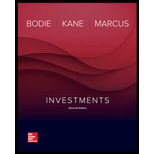
To determine: Reconciliation of the two empirical observations that the price and yields to maturity of long term bonds are more volatile than short term bonds.
Introduction: In long term bonds, the issuer pay higher interest rates for exchange of more security. The short term bonds have minimum period for maturity,but they provide a higher liquidity.
Answer to Problem 1PS
Short term bonds are more volatile in terms of yields to maturity and long term bonds are more volatile in terms of price.
Explanation of Solution
Given Information:
Prices and yields to maturity for both long and short terms of bond are given.
As in Short term bonds, the yielding amount is low the risk factor involved is minimum. On the other hand the long term bonds pose agreater risk, because the investor’s money is locked up for longer period. There would be chances of price fluctuations.
In long term bond, the maturity period is higher in comparison to the short term bonds. So, the price in long term is more sensitive than that of the short term bonds.
The rate of charged interests may be fluctuating with higher duration than the near future. So, yields to maturity in short term bonds are more volatile.
Hence, the long duration of maturity period makes the long term bonds more volatile in price but less volatile in terms of interest.
Want to see more full solutions like this?
Chapter 16 Solutions
Investments
- No chatgptPlease don't answer i will give unhelpful all expert giving wrong answer he is giving answer with using incorrect values.arrow_forwardPlease don't answer i will give unhelpful all expert giving wrong answer he is giving answer with incorrect data.arrow_forward4. On August 20, Mr. and Mrs. Cleaver decided to buy a property from Mr. and Mrs. Ward for $105,000. On August 30, Mr. and Mrs. Cleaver obtained a loan commitment from OKAY National Bank for an $84,000 conventional loan at 5 percent for 30 years. The lender informs Mr. and Mrs. Cleaver that a $2,100 loan origination fee will be required to obtain the loan. The loan closing is to take place September 22. In addition, escrow accounts will be required for all prorated property taxes and hazard insurance; however, no mortgage insurance is necessary. The buyer will also pay a full year's premium for hazard insurance to Rock of Gibraltar Insurance Company. A breakdown of expected settlement costs, provided by OKAY National Bank when Mr. and Mrs. Cleaver inspect the uniform settlement statement as required under RESPA on September 21, is as follows: I. Transactions between buyer-borrower and third parties: a. Recording fees--mortgage b. Real estate transfer tax c. Recording fees/document…arrow_forward
- finance subjectarrow_forwardCould you help explain, what is the complete salary survey analysis, and ensuring the data is relevant and up-to-date? What is the job evaluation and compensation plan? How to ensure the final report is comprehensive, clearly structured, and aligned with the company vision?arrow_forwardThe maturity value of an $35,000 non-interest-bearing, simple discount 4%, 120-day note is:arrow_forward
- Carl Sonntag wanted to compare what proceeds he would receive with a simple interest note versus a simple discount note. Both had the same terms: $18,905 at 10% for 4 years. Use ordinary interest as needed. Calculate the simple interest note proceeds. Calculate the simple discount note proceeds.arrow_forwardWhat you're solving for Solving for maturity value, discount period, bank discount, and proceeds of a note. What's given in the problem Face value: $55300 Rate of interest: 10% Length of note: 95 days Date of note: August 23rd Date note discounted: September 18th Bank discount rate:9 percentarrow_forwardAll tutor giving incorrect solnarrow_forward
 Intermediate Financial Management (MindTap Course...FinanceISBN:9781337395083Author:Eugene F. Brigham, Phillip R. DavesPublisher:Cengage Learning
Intermediate Financial Management (MindTap Course...FinanceISBN:9781337395083Author:Eugene F. Brigham, Phillip R. DavesPublisher:Cengage Learning
